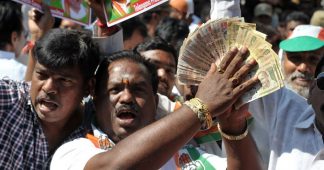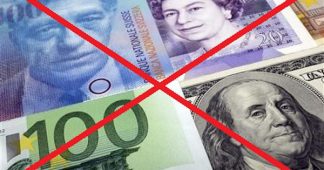The Macroeconomics of De-Cashing: IMF Wants India To Wage War On Cash, Push For A Cashless Society
In the face of strong public opposition the International Monetary Fund (IMF) published a working paper offering governments suggestions on how to move toward a cashless society. In its recent report The Macroeconomics of De-Cashing, the IMF proposed to abolish cash and recommended to adopt measures in order to restrict its use.
The paper defines ‘De-cashing’ as “the gradual phasing out of currency from circulation and its replacement with convertible deposits.” Defined as replacing paper currency with convertible deposits, de-cashing would affect all key macroeconomic sectors.
In order to achieve its goal the paper proposes certain steps that include
“abolishing large denomination bills, imposing ceilings on cash transactions, introducing declaration requirements on the carriage of cash in and out of the country, reporting requirements for cash payments exceeding a specified amount, and even taxing cash transactions.”
In an interview with Sputnik Germany, former head of the Federal Association of German Industry (BDI) Hans-Olaf Henkel said that this “could lead to terrible consequences.“
“The European Central Bank (ECB) does not want that depositors to keep their money under the pillow. If any bank in Europe goes bankrupt, then depositors have a guaranteed right that the state will return them the amount of up to 100,000 euros. But not more,” the economist told Sputnik Germany.
One of the main reasons behind this proposal is the desire of financial institutions to force people to keep their money in banks. As explained in our exclusive report on the global War on Cash: Target India,
“These are classic strategies to avoid a Bank Run. A Bank Run occurs when a large number of customers withdraw cash from deposit accounts with a financial institution at the same time because they believe that the financial institution is, or might become, insolvent. As a Bank Run progresses, it generates its own momentum: as more people withdraw cash, the likelihood of default increases, triggering further withdrawals. This can destabilize the bank to the point where it runs out of cash and thus faces sudden bankruptcy. To combat a Bank Run, a bank may limit how much cash each customer may withdraw or suspend withdrawals altogether.
When Indian banks were flooded with cash deposits, one frequent question that was being raised was how much of these extra deposits would be permanent? Would bank customers withdraw the money after the situation went back to normal, or would they decide not to keep so much cash in hand, and rather keep it in the bank? The answer would determine whether the surge in bank liquidity would continue and, therefore, mean lower interest rates on bank deposits for longer. A vague atmosphere of conflicting policies that is being maintained by the Indian government and the Reserve Bank of India discourages this practice and ensures that the deposits stay with the banks.
Whether the customers go for a Bank Run or not the extra cash deposits gathered by demonetization is sticky and the stark reality is that the entire demonetization exercise to bailout the banks may have just managed to sustain the crisis for another 6-8 months. The state of public sector banks has only worsened since.
What is taking place today is the greatest transfer of public wealth into private hands in the history of this world. Contrary to a myth long popular in the West and now espoused by the East it’s been the poor of the world that finance the rich not the other way round. At the end it was the decades of hard earned public money that was sucked to bail out the ailing Indian banking system that in turn would bailout and stabilize the bankrupt Western-European economies and corporations.”
There is a war on cash being waged globally and the objective of this war is to push nations into becoming a Cashless Surveillance Society easily managed by the East India Companies in their new avatar as global Multinational Corporations.











